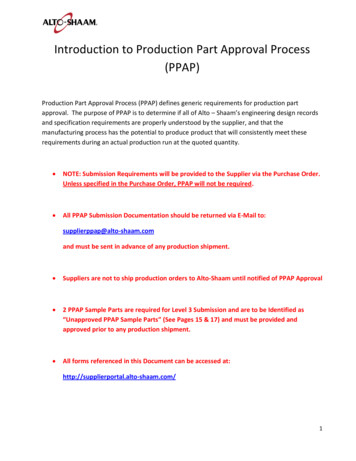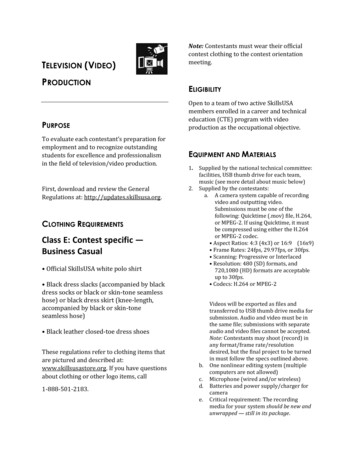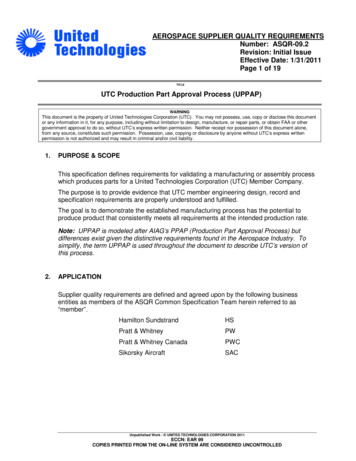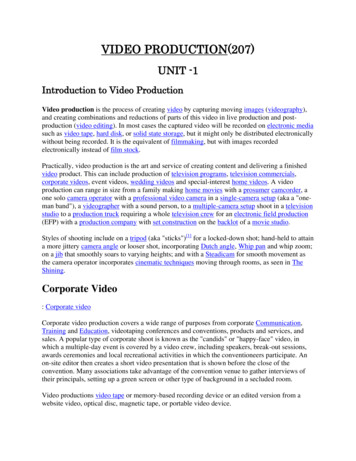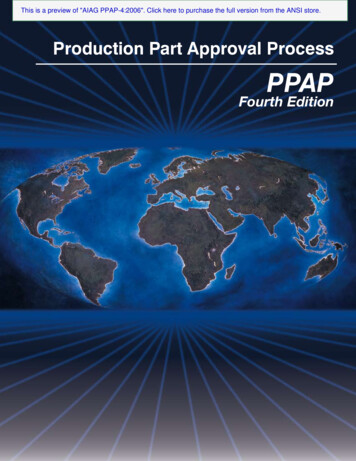
Transcription
This is a preview of "AIAG PPAP-4:2006". Click here to purchase the full version from the ANSI store.Production Part Approval ProcessPPAPFourth Edition
This is a preview of "AIAG PPAP-4:2006". Click here to purchase the full version from the ANSI store.Production Part Approval Process (PPAP)First Edition Issued February 1993Second Edition, 1st Printing, February 1995; 2nd Printing, July 1995Third Edition, September 1999; 2nd Printing, August 2000Fourth Edition, March 2006Copyright 1993, 1995, 1997, 1999, 2000, 2006DaimlerChrysler Corporation, Ford Motor Company, General Motors CorporationEffective June 1, 2006, PPAP Fourth Edition replaces PPAP Third Editionunless otherwise specified by your customer.Further copies are obtainable from AIAG at 1-248-358-3003 orAdareCarwin (UK) in Europe 44-1-708-861333
This is a preview of "AIAG PPAP-4:2006". Click here to purchase the full version from the ANSI store.PPAP (Production Part Approval Process) 4th Edition Errata SheetPageOriginal Language (see highlight)iiPPAP Process Flowchart Exampleii22The flowchart is an example, and isnot meant to be interpreted torepresent the only possible processflow for PPAP. This is not amandatory process flow.Validated ProcessPSO or Run at Rate may be required[PSO / Run at Rate]by certain OEMs or other customersprior to PPAP Warrant submission.IMDS/Other Customer Format: Circle IMDS/Other Customer Format: Circleeither “IMDS” or “Other Customereither “IMDS” or “Other CustomerFormat” as appropriate. If submitted Format” as appropriate. If submittedvia IMDS include: Module ID #,via IMDS include: Module ID #,Version #, and Creation Date. IfVersion #, and Date Transmitted tosubmitted via other customer format, the customer, and all otherenter the date customer confirmation information as required by thewas received.customer specifics. If submitted viaother customer format, enter the datecustomer confirmation was received.23Has customer-required Substancesof Concern information beenreported? Yes No n/a23Has customer-required Substancesof Concern information beenreported? YesNo n/aDECLARATIONI affirm that the samples representedby this warrent are representative ofour parts, which were made by aprocess that meets all ProductionPart Approval Process Manual 4thEdition Requirements.23285051515252Corrected Version Language orexplanationSUPPLIER NAME (item 8, asindicated on page 27)SUPPLIER/VENDOR CODE (line 3)SUPPLIER NAME (item 1)SUPPLIER CODE (item 3)SUPPLIER NAME (item 1 asindicated on page 51)SUPPLIER CODE (item 3 asindicated on page 51)19 July 2006Reporting of all materials, not justSubstances of Concern, may berequired by certain OEMs or othercustomersHas customer-required Substancesof Concern information beenreported? YesNoDECLARATIONI affirm that the samples representedby this warrant are representative ofour parts, which were made by aprocess that meets all ProductionPart Approval Process Manual 4thEdition Requirements.ORGANIZATION NAMEORGANIZATION (VENDOR) CODEORGANIZATION NAMEORGANIZATION (VENDOR) CODEORGANIZATION NAMEORGANIZATION (VENDOR) CODEPage 1 of 1
This is a preview of "AIAG PPAP-4:2006". Click here to purchase the full version from the ANSI store.FOREWORD TO THE FOURTH EDITIONEffective June 1, 2006, PPAP Fourth Edition replaces PPAP Third Edition, unless otherwise specified byyour customer.Production Part Approval Process (PPAP) is updated to the 4th edition to incorporate the customerfocused process approach associated with ISO/TS 16949:2002 and other changes listed below to updaterequirements.PPAP’s purpose continues to be to provide the evidence that all customer engineering design record andspecification requirements are properly understood by the organization and that the manufacturingprocess has the potential to produce product consistently meeting these requirements during an actualproduction run at the quoted production rate.PPAP 4th Edition includes the following changes: Alignment of PPAP to the ISO/TS 16949:2002 process approach, including: Aligning the order of the PPAP requirements with the automotive product development andmanufacturing processInclusion of an example process flow for PPAP Relocation of Customer Specific Instructions to appropriate websites, (e.g. OEM and IAOB,www.iaob.org) to provide current requirements Update of Truck OEM requirements and moved to Appendix H Revised PSW (Part Submission Warrant) to: Provide a more logical flow for the part / design description fieldsMake the supplier address fields applicable to international locationsInclude IMDS materials reporting to indicate reporting statusUpdated specific PPAP requirements, including: Materials reporting and polymeric identification requirements in the design recordProcess capability index usage (Cpk and Ppk)The definition and approval of catalog parts and the definition of black box parts Modified customer notification and submission requirements to align with OEM requirements(e.g., I.3.3 from PPAP 3rd removed) Clarified and commonized Appendices C, D, and E to match the PPAP reporting requirements Revised Tire Appendix to allow OEM specification of applicability and to eliminate duplicationswith allowances already provided in the PPAP requirementsNote: The Tire Appendix is not applicable to organizations supplying tires to Ford Motor Company. Reorganized and updated Appendix F to stress the importance of the Bulk Materials ChecklistNote: Ford Motor Company requires all organizations supplying bulk material to Ford Motor Company tocomply with PPAP. Revised Glossary to be consistent with the updates in the textPPAP refers to the following reference manuals: Advanced Product Quality Planning & Control Plan,Potential Failure Modes and Effects Analysis, Measurement System Analysis, and StatisticalProcess Control. These manuals are authored by DaimlerChrysler Corporation, Ford Motor Company,and General Motors Corporation and are available through the Automotive Industry Action Group (AIAG)at www.aiag.org.The Supplier Quality Requirements Task Force gratefully acknowledges the contributions of the manyindividuals and their respective companies that participated in the revision process.i
This is a preview of "AIAG PPAP-4:2006". Click here to purchase the full version from the ANSI store.ii
This is a preview of "AIAG PPAP-4:2006". Click here to purchase the full version from the ANSI store.TABLE OF CONTENTSINTRODUCTION.1Purpose .1Applicability.1Approach .1SECTION 1 – GENERAL .31.1Submission of PPAP .3SECTION 2 – PPAP PROCESS REQUIREMENTS.32.1Significant Production Run.32.2PPAP Requirements.32.2.1 Design Record . 42.2.2 Authorized Engineering Change documents . 52.2.3 Customer Engineering Approval . 52.2.4 Design Failure Mode and Effects Analysis (Design FMEA). 52.2.5 Process Flow Diagram(s) . 52.2.6 Process Failure Mode and Effects Analysis (Process FMEA) . 52.2.7 Control Plan. 52.2.8 Measurement System Analysis Studies . 62.2.9 Dimensional Results. 62.2.10 Records of Material / Performance Test Results . 62.2.11 Initial Process Studies. 72.2.12 Qualified Laboratory Documentation. 102.2.13 Appearance Approval Report (AAR) . 102.2.14 Sample Production Parts. 102.2.15 Master Sample. 102.2.16 Checking Aids . 112.2.17 Customer-Specific Requirements . 112.2.18 Part Submission Warrant (PSW) . 11SECTION 3 – CUSTOMER NOTIFICATION AND SUBMISSION REQUIREMENTS .133.1 Customer Notification.133.2 Submission to Customer.15SECTION 4 – SUBMISSION TO CUSTOMER - LEVELS OF EVIDENCE.174.1 Submission Levels .17SECTION 5 – PART SUBMISSION STATUS.195.1 General .195.2 Customer PPAP Status .195.2.15.2.2Approved . 19Interim Approval . 19iii
This is a preview of "AIAG PPAP-4:2006". Click here to purchase the full version from the ANSI store.5.2.3Rejected . 19SECTION 6 – RECORD RETENTION .21APPENDICIESAPPENDIX A – COMPLETION OF THE PART SUBMISSION WARRANT (PSW) .22APPENDIX B – COMPLETION OF THE APPEARANCE APPROVAL REPORT .26APPENDIX C – PRODUCTION PART APPROVAL, DIMENSIONAL RESULTS.29APPENDIX D – PRODUCTION PART APPROVAL, MATERIAL TEST RESULTS .31APPENDIX E – PRODUCTION PART APPROVAL, PERFORMANCE TEST RESULTS .33APPENDIX F – BULK MATERIAL - SPECIFIC REQUIREMENTS .35APPENDIX G – TIRES - SPECIFIC REQUIREMENTS .55APPENDIX H – TRUCK INDUSTRY - SPECIFIC REQUIREMENTS .57GLOSSARY.65iv
This is a preview of "AIAG PPAP-4:2006". Click here to purchase the full version from the ANSI store.INTRODUCTIONPurposeProduction Part Approval Process (PPAP) defines generic requirements for production part approval,including production and bulk materials (see Glossary). The purpose of PPAP is to determine if allcustomer engineering design record and specification requirements are properly understood by theorganization and that the manufacturing process has the potential to produce product consistently meetingthese requirements during an actual production run at the quoted production rate.ApplicabilityPPAP shall apply to internal and external organization sites (see Glossary) supplying production parts,service parts, production materials, or bulk materials. For bulk materials, PPAP is not required unlessspecified by the authorized customer representative.An organization supplying standard catalog production or service parts shall comply with PPAP unlessformally waived by the authorized customer representative.NOTE 1: See customer-specific requirements for additional information. All questions about PPAPshould be addressed to the authorized customer representative.NOTE 2: A customer can formally waive PPAP requirements for an organization. Such waivers can onlybe issued by an authorized customer representative.NOTE 3: An organization or supplier requesting a waiver of a PPAP requirement should contact theauthorized customer representative. The organization or supplier should obtain documentation of waiversfrom the authorized customer representative.NOTE 4: Catalog parts (e.g., bolts) are identified and/or ordered by functional specifications or byrecognized industry standards.ApproachThe word “shall” indicates mandatory requirements. The word “should” indicates a recommendation.Paragraphs marked “NOTE” are for guidance in understanding or clarifying the associated requirement.The word “should” appearing in a NOTE is for guidance only.For the purposes of PPAP, the terms and definitions given in ISO/TS 16949 and the PPAP Glossaryapply.1
This is a preview of "AIAG PPAP-4:2006". Click here to purchase the full version from the ANSI store.2
This is a preview of "AIAG PPAP-4:2006". Click here to purchase the full version from the ANSI store.SECTION 1 – GENERAL1.1 Submission of PPAPThe organization shall obtain approval (see 5.2.1) from the authorized customer representative for:1. a new part or product (e.g., a specific part, material, or color not previously supplied to thespecific customer).2. correction of a discrepancy on a previously submitted part.3. product modified by an engineering change to design records, specifications, or materials.4. any situation required by Section 3.NOTE: If there is any question concerning the need for production part approval, contact the authorizedcustomer representative.SECTION 2 – PPAP PROCESS REQUIREMENTS2.1 Significant Production RunFor production parts, product for PPAP shall be taken from a significant production run. Thissignificant production run shall be from one hour to eight hours of production, and with the specificproduction quantity to total a minimum of 300 consecutive parts, unless otherwise specified by theauthorized customer representative.This significant production run shall be conducted at the production site, at the production rate (seeGlossary) using the production tooling, production gaging, production process, production materials, andproduction operators. Parts from each unique production process, e.g., duplicate assembly line and/orwork cell, each position of a multiple cavity die, mold, tool or pattern, shall be measured andrepresentative parts tested.For bulk materials: No specific number of “parts” is required. The submitted sample shall be taken in amanner as to assure that it represents “steady-state” operation of the process.NOTE: For bulk material, production histories of current products may often be used to estimate the initialprocess capability or performance of new and similar products. In cases where no production history of asimilar bulk material product or technology exists, a containment plan may be put into effect until sufficientproduction has demonstrated capability or performance, unless otherwise specified by the customer.2.2 PPAP RequirementsThe organization shall meet all specified PPAP requirements listed below (2.2.1 through 2.2.18). Theorganization shall also meet all customer-specific PPAP requirements.Production parts shall meet all customer engineering design record and specification requirements(including safety and regulatory requirements).Bulk Material PPAP requirements are defined by a completed Bulk Material Requirements Checklist (seeAppendix F).3
This is a preview of "AIAG PPAP-4:2006". Click here to purchase the full version from the ANSI store.If any part specifications cannot be met, the organization shall document their problem-solving effortsand shall contact the authorized customer representative for concurrence in determination of appropriatecorrective action.NOTE: Items or records from 2.2.1 through 2.2.18 may not necessarily apply to every customer partnumber from every organization. For example, some parts do not have appearance requirements, others donot have color requirements, and plastic parts may have polymeric part marking requirements. In order todetermine with certainty which items must be included, consult the design record, e.g., part print, therelevant Engineering documents or specifications, and your authorized customer representative.2.2.1 Design RecordThe organization shall have the design record for the saleable product/part, including design records forcomponents or details of the saleable product/part. Where the design record is in electronic format, e.g.,CAD/CAM math data, the organization shall produce a hard copy (e.g., pictorial, geometric dimensioning& tolerancing [GD&T] sheets, drawing) to identify measurements taken.NOTE 1: For any saleable product, part or component, there will only be one design record, regardless ofwho has design-responsibility. The design record may reference other documents making them part of thedesign record.NOTE 2: A single design record can represent multiple part or assembly configurations, e.g., a sub-frameassembly with various hole configurations for different applications.NOTE 3: For parts identified as black box (see Glossary), the design record specifies the interface andperformance requirements.NOTE 4: For parts identified as catalog parts, the design record may consist only of a functionalspecification or a reference to a recognized industry standard.NOTE 5: For bulk materials, the design record may include identification of raw materials, formulations,processing steps and parameters, and final product specifications or acceptance criteria. If dimensionalresults do not apply, then CAD/CAM requirements are also not applicable.2.2.1.1 Reporting of Part Material CompositionThe organization shall provide evidence that the Material/Substance Composition reporting that isrequired by the customer has been completed for the part and that the reported data complies with allcustomer-specific requirements.NOTE: This materials reporting may be entered into the IMDS (International Materials Data System) orother customer-specified system/method. IMDS is available through http://www.mdsystem.com/index.jsp.2.2.1.2 Marking of Polymeric PartsWhere applicable, the organization shall identify polymeric parts with the ISO symbols such as specifiedin ISO 11469, “Plastics – Generic Identification and marking of plastic products” and/or ISO 1629,“Rubber and lattices – Nomenclature.” The following weight criteria shall determine if the markingrequirement is applicable: Plastic parts weighing at least 100g (using ISO 11469/1043-1)Elastomeric parts weighing at least 200g (using ISO 11469/1629)NOTE: Nomenclature and abbreviation references to support the use of ISO 11469 are contained in ISO1043-1 for basic polymers and in ISO 1043-2 for fillers and reinforcements.4
This is a preview of "AIAG PPAP-4:2006". Click here to purchase the full version from the ANSI store.2.2.2 Authorized Engineering Change documentsThe organization shall have any authorized engineering change documents for those changes not yetrecorded in the design record but incorporated in the product, part or tooling.2.2.3 Customer Engineering ApprovalWhere specified by the customer, the organization shall have evidence of customer engineering approval.NOTE: For bulk materials, this requirement is satisfied by a signed ‘Engineering Approval’ line item onthe Bulk Material Requirements Checklist (see Appendix F) and/or inclusion on a customer maintained listof approved materials.2.2.4 Design Failure Mode and Effects Analysis (Design FMEA)if the organization is product design-responsibleThe product design-responsible organization shall develop a Design FMEA in accordance with, andcompliant to, customer-specified requirements (e.g., Potential Failure Mode and Effects Analysisreference manual).NOTE 1: A single Design FMEA may be applied to a family of similar parts or materials.NOTE 2: For bulk materials, see Appendix F.2.2.5 Process Flow Diagram(s)The organization shall have a process flow diagram in an organization-specified format that clearlydescribes the production process steps and sequence, as appropriate, and meets the specified customerneeds, requirements and expectations (e.g., Advanced Product Quality Planning and Control Planreference manual). For bulk materials, an equivalent to a Process Flow Diagram is a Process FlowDescription.NOTE: Process flow diagrams for ‘families’ of similar parts are acceptable if the new parts have beenreviewed for commonality by the organization.2.2.6 Process Failure Mode and Effects Analysis (Process FMEA)The organization shall develop a Process FMEA in accordance with, and compliant to, customer-specifiedrequirements, (e.g., Potential Failure Mode and Effects Analysis reference manual).NOTE 1: A single Process FMEA may be applied to a process manufacturing a family of similar parts ormaterials if reviewed for commonality by the organization.NOTE 2: For bulk materials, see Appendix F.2.2.7 Control PlanThe organization shall have a Control Plan that defines all methods used for process control and complieswith customer-specified requirements (e.g., Advanced Product Quality Planning and Control Planreference manual).NOTE 1: Control Plans for “families” of parts are acceptable if the new parts have been reviewed forcommonality by the organization.NOTE 2: Control Plan approval may be required by certain customers.5
i FOREWORD TO THE FOURTH EDITION Effective June 1, 2006, PPAP Fourth Edition replaces PPAP Third Edition, unless otherwise specified by your customer. Production Part Approval Process (PPAP) is updated to the 4th edition to incorporate the customer focused process approach associated with ISO/TS 16949:2002 and other changes listed below to update
